
A Camden high school math teacher explains how she uses Defined Learning to drive student engagement and achievement.
- Subject:
- Education
- Material Type:
- Primary Source
- Author:
- Danielle Hallinan
- Date Added:
- 08/16/2023

A Camden high school math teacher explains how she uses Defined Learning to drive student engagement and achievement.

This course examines the history of MIT through the lens of the broader history of science and technology, and vice versa. The course covers the founding of MIT in 1861 and goes through the present, including such topics as William Barton Rogers, educational philosophy, biographies of MIT students and professors, intellectual and organizational development, the role of science, changing laboratories and practices, and MIT's relationship with Boston, the federal government, and industry. Assignments include short papers, presentations, and final paper. A number of classes are concurrent with the MIT150 Symposia.
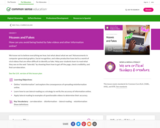
We know not to believe everything we hear, but what about what we see? Advancements in computer-generated graphics, facial recognition, and video production have led to a world of viral videos that are often difficult to identify as fake. Help your students learn to read what they see on the web "laterally" by showing them how to get off the page, check credibility, and find corroboration.
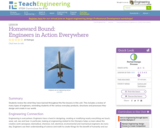
Students review the what they have learned throughout the five lessons in this unit. This includes a review of many types of engineers, reminding students of the various everyday products, structures and processes they design and create in our world.
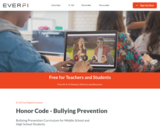
Honor Code provides students with an immersive digital learning experience designed to help them recognize the cause and effect of bullying while building the skills necessary to prevent bullying in their communities. This interactive digital resource covers topics such as relationships, leadership, resilience, courage, and community.
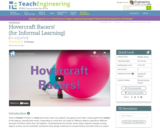
Students learn about friction and its effects on motion by building model hovercrafts.
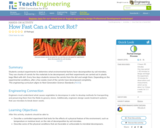
Students conduct experiments to determine what environmental factors favor decomposition by soil microbes. They use chunks of carrots for the materials to be decomposed, and their experiments are carried out in plastic bags filled with dirt. Every few days students remove the carrots from the dirt and weigh them. Depending on the experimental conditions, after a few weeks most of the carrots have decomposed completely.
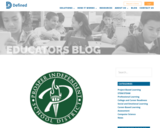
Michael Pflug, the K-12 STEAM Curriculum Designer for Prosper ISD believes that learners must be put in situations that replicate what they will be doing in the real world. “The way our society is going we need to prepare students with technical skills and prepare them for all post-secondary options. Project Based Learning (PBL) does that.
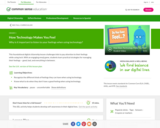
This foundational digital citizenship lesson challenges kids to pay attention to their feelings while using tech. With an engaging emoji game, students learn practical strategies for managing their feelings -- good, bad, and everything in between.
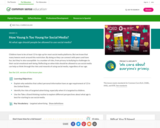
Children have to be at least 13 to sign up for most social media platforms. But we know that many tweens work around this restriction. By doing so they can connect with peers and have fun, but they're also susceptible to a number of risks, from privacy to bullying to challenges to their social-emotional well-being. Reflecting on when kids should be allowed to use social media can help us think through the risks and rewards of using social media, regardless of our age.

Brief video describing where and how to find Open Educational Resources, including specific repositories and licences to look for.
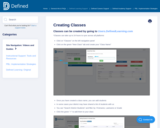
Classes can be created by going to users.definedlearning.com.
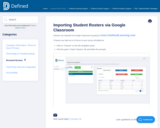
Classes can be imported via Google Classroom by going to users.definedlearning.com.

Defined Learning’s platform provides students with a project based learning approach. Students solve real world problems or challenges. While logged into the site, search for a project through courses and units, through a standards approach, or by grade levels and content areas.
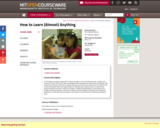
Examines how new computational tools and activities can help people learn new things in new ways. Discusses theories of learning and education underlying the design and use of these tools, and explores how new tools can change the ways people think about learning and education. Special emphasis on "constructionist" approaches to learning (represented by tools such as StarLogo and programmable LEGO bricks). Final project involves the design and observation of learning activities. As the digital revolution brings with it radical changes in how and what we learn, people must continue to learn all the time. New technologies make possible new approaches to learning, new contexts for learning, new tools to support learning, and new ideas of what can be learned. This course will explore these new opportunities for learning with a special focus on what can be learned through immersive, hands-on activities. Students will participate in (and reflect on) a variety of learning situations, and will use Media Lab technologies to develop new workshops, iteratively run and refine the workshops, and analyze how and what the workshop participants learn.
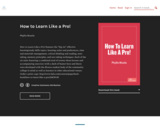
How to Learn Like a Pro! features the “big six” effective learning/study skills topics:
- Learning styles and preferences
- Time and materials management
- Critical thinking and reading
- Note-taking
- Memory principles and techniques
- Test-taking
Each of the six units featuring a total of twenty-three lessons and accompanying exercises (with a dash of humor here and there) were developed with the diverse student body of the community college in mind as well as learners in other educational venues.

Students measure and analyze forces that act on vehicles pulling heavy objects while moving at a constant speed on a frictional surface. They study how the cars interact with their environments through forces, and discover which parameters in the design of the cars and environments could be altered to improve vehicles' pulling power. This LEGO® MINDSTORMS® based activity is geared towards, but not limited to, physics students.
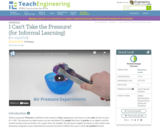
Students learn about pressure, employing it to crush cans and model the atmosphere.
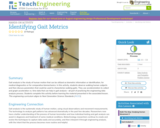
Gait analysis is the study of human motion that can be utilized as biometric information or identification, for medical diagnostics or for comparative biomechanics. In this activity, students observe walking human subjects and then discuss parameters that could be used to characterize walking gaits. They use accelerometers to collect and graph acceleration vs. time data that can help in gait analysisâall part of practicing the engineering data analysis process. Students complete this activity before learning the material presented in the associated lesson.
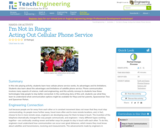
In this role-playing activity, students learn how cellular phone service works, its advantages and its limitations. Students also learn about the advantages and limitations of satellite phone service. Phone communication involves many aspects of science, math and engineering, and this activity conveys to students how these technologies help people to stay better connected. Students use what they learn to understand what communication options might be available for Maya and her parents, Spacewoman Tess and Spaceman Rohan.